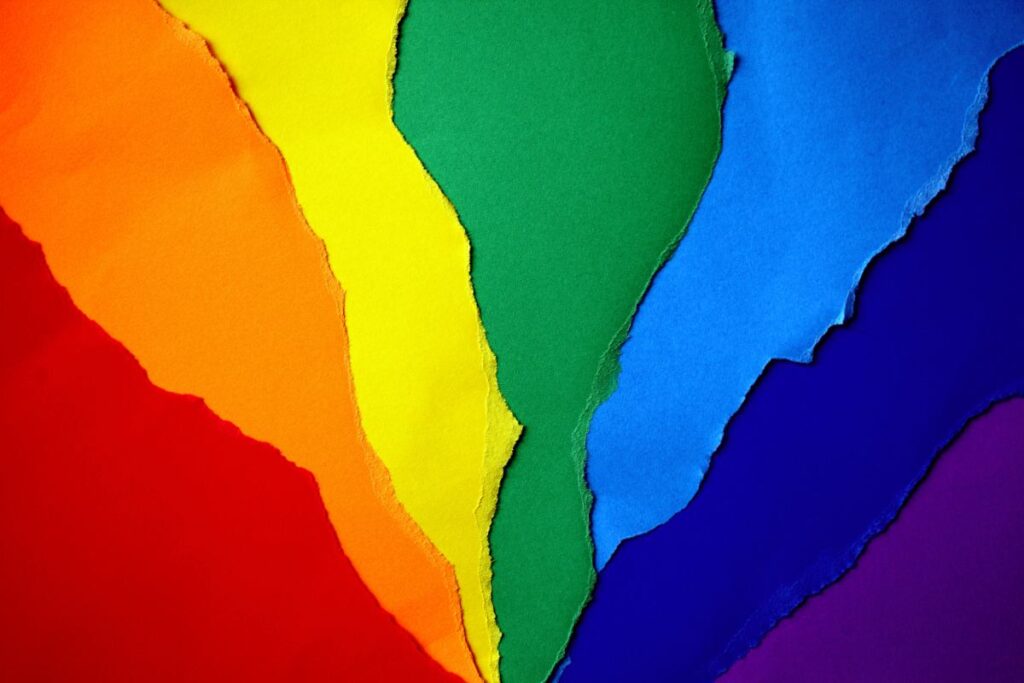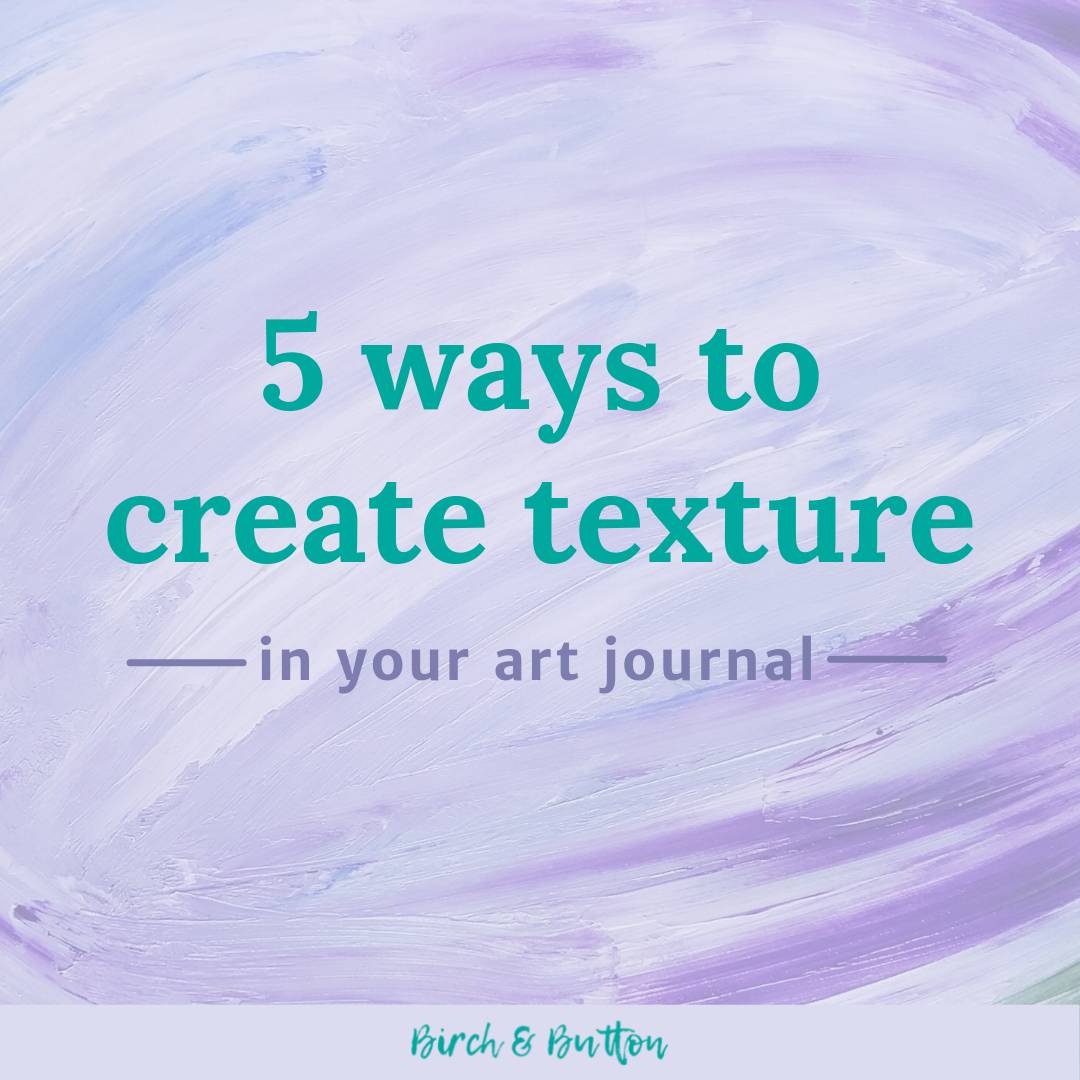If you want to take your art journal pages up a notch, try adding some different textures. Read on for five ways to create texture in your art journal.
When you’re creating an art journal page, there are lots of things you might want to try including:
- Different colours
- Patterns
- Images
- Words
- Embellishments
You’re likely to mix it up. Some days you might focus on one of these things and others you might feel like throwing a bit more at the page you’re working on. It all depends what you’re trying to convey or achieve with the page.
One other thing I haven’t yet mentioned is what this article is all about: texture. Texture is great for giving an art journal page a bit of extra interest and another dimension. And the great thing is there’s a variety of ways to create texture in your art journal
Different textures make art journal spreads much more tactile, encouraging people to touch rather than just look.
And it doesn’t matter if you let other people look through your art journal or prefer to keep it private.
Even if it’s just you looking back in a month or year, incorporating different textures means you’ll experience what you created in a different way than if you just look at it.
So let’s take a look at five ways to create texture in your art journal.
Sign up for my monthly emails of creative tips, tutorials and DIYs and get 31 free creative prompts!

You can unsubscribe at any time
1. Torn paper
When you tear paper, you end up with a really interesting edge.
Try layering up pieces of torn paper, with each piece of paper slightly smaller than the last.
Thicker papers are perfect for this, as are handmade papers that tend to have a little more texture. And coloured papers can also create an interesting effect when torn.
Try not to be too precious about how you want the torn edge to look. It’s often pretty tricky to get it spot on how you want it, but a tip to make it easier is to tear along the grain of the paper. This is easier than tearing across it.
If you’re not sure which way the paper fibres are lying, try doing two small tears. Make sure they’re at right angles to each other, and take note which direction was easiest to tear in. That’s the direction the paper fibres are lying, so it’ll be easier to control any tears running in this direction.
Whatever happens, don’t beat yourself up if it doesn’t turn out quite how you wanted. I’m sure you can make it work anyway!

2. Sand
Sand is surprisingly versatile as an arts and crafts supply, and it’s easy to get hold of.
I wouldn’t recommend going down to the beach (if you have one near you) and bringing some sand home with you. Instead, you can easily buy different kinds of sand pretty cheaply.
Big bags of natural coloured sand are available anywhere you might buy a child’s sand pit from. This is ideal for anyone likely to use a lot in projects. (And even better, if you have a child with a sand pit, I’m sure they wouldn’t notice if a little sand went missing…)
Otherwise, you can get coloured sand from craft shops. You can also get sand texture gels from shops that sell art supplies.
If you want to retain the colour of the sand, you can mix it into clear-drying craft glue then use it in your art journal.
Otherwise, you can mix sand into different coloured paints for a variety of effects. Acrylic paints work well for this.
One thing to bear in mind is that sand is abrasive, so take care and cover any polished or delicate surfaces when using it.
You should also be aware that it can shred your brushes, so don’t use expensive brushes when working with sand!
3. Fabric
Small pieces of different fabrics can be used to great effect. And lace or ribbon are also useful for creating texture in your art journal.
You could make a patchwork background with scraps, or create a landscape with green and blue patterned fabrics.
Art journaling is a great way to use up scraps of fabric, so if you have any leftovers from sewing projects, make sure you keep hold of them for the future. It’s even better if you have fabrics of different textures and thicknesses.
Simple white craft glue should be all you need to stick your fabric, lace or ribbon to the page. Just make sure the glue you use dries clear and doesn’t turn yellow, as that will ruin the look of your fabric.
Another way to attach fabric is to sew it onto the page using a needle and thread. In fact, stitching is another nice way of adding texture to the page, so there’s an extra bonus way of creating texture for you to consider using!
4. Scrunched paper
Crumpled paper is another versatile way to create texture in your art journal.
Scrunch up a piece of paper into a ball and then open it out again. Mix some white craft glue with a little water and paint it onto the page.
Stick the piece of paper down and paint some more of the glue mixture over the top. Let it dry and you’ll have created a papier mache effect.
You can also stick tiny scrunched up paper balls to the page to create a different kind of texture. Tissue paper works well when used in this way.
Bear in mind this will add bulk to your art journal, so if you’re not a fan of a chunky book this might not be the technique for you!

5. Thick paint
Thick paint can add some lovely texture to an art journal page or other artwork. Heavy body acrylic paint is perfect as it has a lovely thick texture straight out of the tube and is easy to work with.
Thick paint is best applied with a palette knife or something similar, like an old credit card or even a thick piece of card.
Anything you can use to scoop and spread paint is perfect. Just make sure you don’t use something precious, as acrylic paint can stain and at least a little paint is bound to dry onto whatever you use.
You can also mix some impasto gel medium into your paint to get a similar outcome. (Impasto is a technique often associated with oil painting, where the artist applies the paint thickly so it holds the brush strokes and other marks.)
Heavy body acrylics are a great place to start as they don’t need any medium to achieve some great effects. Just bear in mind that thick paint will take longer to fully dry.
Now it’s over to you: do you have any other favourite methods of adding texture to an art journal page? Please share in the comments!
About Stacey

I’m Stacey and I’m a blogger, abstract artist and freelance writer. My aim is to help busy people feel inspired and get more creative with tutorials, hints and tips.
I live in Cardiff with my partner and dog, and in my free time you’ll find me hiking, reading, painting or sampling a craft beer or two.

